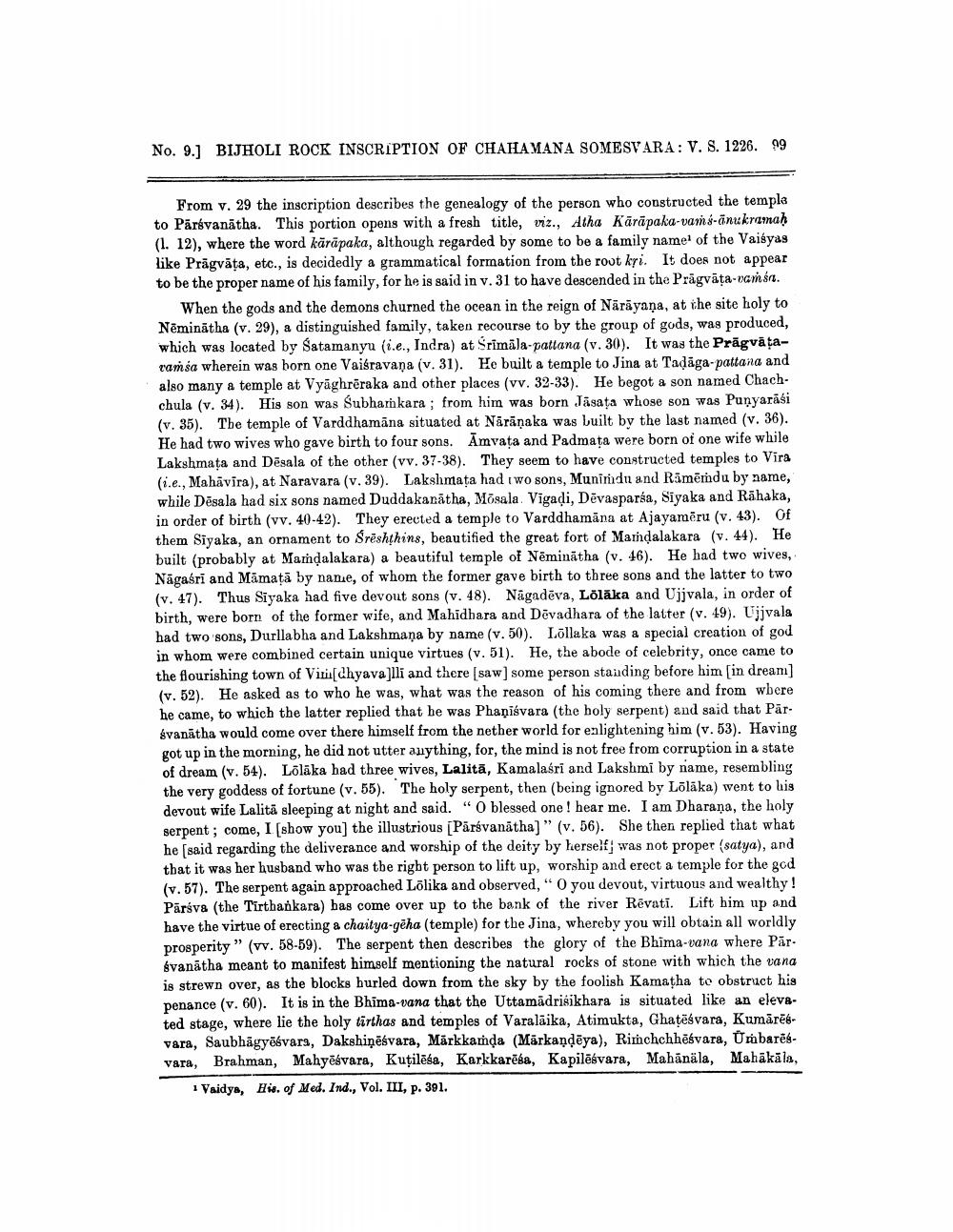________________
No. 9.] BIJHOLI ROCK INSCRIPTION OF CHAHAMANA SOMESVARA: V. S. 1226.99
From v. 29 the inscription describes the genealogy of the person who constructed the templa to Pārsvanātha. This portion opens with a fresh title, viz., Atha Kārāpaka-vams-anu kramah (1. 12), where the word käräpaka, although regarded by some to be a family names of the Vaisyas like Prägvāta, etc., is decidedly a grammatical formation from the root kri. It does not appear to be the proper name of his family, for he is said in v. 31 to have descended in the Prägvāța-vamón.
When the gods and the demons churned the ocean in the reign of Nārāyaṇa, at the site holy to Nēminātha (v. 29), a distinguished family, taken recourse to by the group of gods, was produced, which was located by Satamanyu (i.e., Indra) at Srimāla-pattana (v. 30). It was the Prāgvātavamsa wherein was born one Vaisravana (v. 31). He built a temple to Jina at Tadäga-pattana and also many a temple at Vyāghrēraka and other places (vv. 32-33). He begot a son named Chachchula (v. 34). His son was Subhamnkara; from him was born Jäsata whose son was Punyarāśi (v. 35). The temple of Varddhamana situated at Närāņaka was built by the last named (v. 36). He had two wives who gave birth to four sons. Amvata and Padmata were born of one wife while Lakshmata and Dēsala of the other (vv. 37-38). They seem to have constructed temples to Vira (i.e., Mahāvīra), at Naravara (v. 39). Lakshmata had I wo sons, Munindu and Rāmēmdu by name, while Dēsala had six sons named Duddakanātha, Mõsala. Vigadi, Dévasparsa, Siyaka and Rāhaka, in order of birth (vv. 40-42). They erected a temple to Varddhamāna at Ajayamēru (v. 43). Of them Siyaka, an ornament to Śrēshthins, beautified the great fort of Mandalakara (v. 44). He built (probably at Mandalakara) a beautiful temple of Nēminātha (v. 46). He had two wives, Nāgasri and Māmatā by nanie, of whom the former gave birth to three sons and the latter to two (v. 47). Thus Siyaka had five devout sons (v. 48). Nāgadēva, Lolāka and Ujjvala, in order of birth, were born of the former wife, and Mahidhara and Dēvadhara of the latter (v. 49). Ujjvala had two sons, Durllabha and Lakshmana by name (v. 50). Lõllaka was a special creation of god in whom were combined certain unique virtues (v. 51). He, the abode of celebrity, once came to the flourishing town of Viri[Chyava]lli and there (saw) some person standing before him (in dream] (v. 52). He asked as to who he was, what was the reason of his coming there and from wbere he came, to which the latter replied that he was Phaņisvara (the holy serpent) and said that Pār. gvanātha would come over there himself from the nether world for enlightening him (v. 53). Having got up in the morning, he did not utter anything, for, the mind is not free from corruption in a state of dream (v. 54). Lõlāka had three wives, Lalitā, Kamalasri and Lakshmi by name, resembling the very goddess of fortune (v. 55). The holy serpent, then (being ignored by Löläka) went to his devout wife Lalita sleeping at night and said. “O blessed one! hear me. I am Dharana, the holy serpent; come, I show you) the illustrious [Pārsvanātha]" (v. 56). She then replied that what he said regarding the deliverance and worship of the deity by herself was not proper satya), and that it was her husband who was the right person to lift up, worship and erect a temple for the god (v. 57). The serpent again approached Lolika and observed, " O you devout, virtuous and wealthy! Pārsvę (the Tirthankara) bas come over up to the bank of the river Rêvati. Lift him up and have the virtue of erecting a chaitya-gēha (temple) for the Jina, whereby you will obtain all worldly prosperity” (vv. 58-59). The serpent then describes the glory of the Bhima-vana where Pār. Svanātha meant to manifest himself mentioning the natural rocks of stone with which the vana is strewn over, as the blocks hurled down from the sky by the foolish Kamatha te obstruct his penance (v. 60). It is in the Bhima-vana that the Uttamādrisikhara is situated like an eleveted stage, where lie the holy tirthas and temples of Varalūika, Atimukta, Ghatëśvara, Kumārēdvara, Saubhāgyēsvara, Dakshiņēsvara, Märkkamda (Märkandēya), Rimchchhēsvara, Umbarësvara, Brahman, Mahyēśvara, Kuțilēsa, Karkkarēba, Kapilēsvara, Mahānäla, Mahākāla,
Vaidys, His. of Med. Ind., Vol. III, p. 391.




